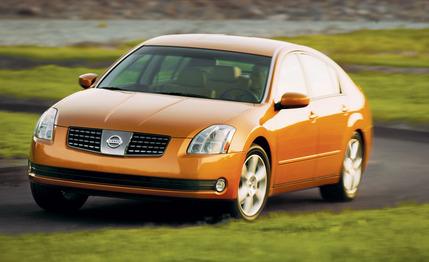
 Road Test
Road Test
Nissan's 2004 Maxima is the sixth-generation sedan to carry that nameplate, and the company is confident that it will satisfy an extremely loyal owner group, many of whom have owned four or five Maximas. This time, Nissan wisely decided to split the model range into sport (SE) and luxury (SL) variants to cover both sides of the market.
We borrowed a 3.5SE six-speed model for evaluation, since the priorities of this magazine tend-as you've possibly noticed-toward the sporting lunatic fringe. All models get the same engine-Nissan's ubiquitous VQ-series 3.5-liter V-6-which seems tunable for almost any application.
In the Maxima, the V-6 produces 265 horsepower and 255 pound-feet of torque, much of which is available throughout a broad engine-speed range. In fact, so torquey is this engine that the driver must take care to launch with relatively few revs on the dial to avoid abusing the clutch.
Thanks to an electronic drive-by-wire throttle that in our test car had a mind of its own, that was easier said than done. In fact, the distinctly nonlinear response we got from our car made performance testing difficult, rendering effective wheelspin modulation a real challenge.
Which probably explains why this car looks slower on paper than the last Maxima we tested in October 2002, requiring 6.4 seconds to achieve 60 mph (instead of 6.0) and 15 seconds flat to cover the quarter-mile. The last Maxima took only 14.7 seconds to do the same job.
Such are the risks one runs with preproduction cars, so don't be surprised to see the figures improve when we test a final-spec production Maxima. However, what probably won't improve is the fairly pronounced torque steer that afflicted our car. Because the Maxima is built on the same front-engine, front-wheel-drive large-car platform as the Altima, it exhibits the same weaving responses to aggressive throttle application, and the same wheel-tugging steering fight.
This sort of insolence cost the Altima dearly in our mainstream-sedan comparison test last month, helping relegate it to a sixth-place tie, and we're disappointed to see the same symptoms manifested so clearly in the new Maxima. Audi has a well-publicized suspension geometry that quells this kind of thing, and most of the other players in the front-drive, high-torque category have dealt with it to a reasonably satisfactory extent. So why not Nissan?
It raises questions about possible cost-cutting measures necessary for an aggressive model-rollout strategy. Although this may prove to be a gamble that pays off as Nissan's business case improves, it's a regrettable flaw in an otherwise attractive product.
For this 2004 rebirth, Nissan kept the Maxima concept close to the current formula, with changes to interior dimensions so slight they are unlikely to be noticed. For example, front headroom is reduced by 0.8 inch, and rear hiproom increases by 1.1 inches. Basically, there's still enough space in this car to comfortably convey four adults, even with a new arched roofline that trims rear headroom by 0.3 inch.